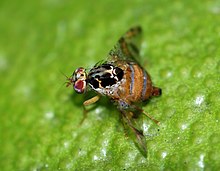Ceratitis capitata
| Ceratitis capitata | |
|---|---|
 |
|
| Scientific classification | |
| Kingdom: | Animalia |
| Phylum: | Arthropoda |
| Class: | Insecta |
| Order: | Diptera |
| Family: | Tephritidae |
| Genus: | Ceratitis |
| Species: | C. capitata |
| Binomial name | |
|
Ceratitis capitata (Wiedemann, 1824) |
|
| Synonyms | |
| External identifiers for Ceratitis capitata | |
|---|---|
| Encyclopedia of Life | 723951 |
| ITIS | 143196 |
| NCBI | 7213 |
| Also found in: | |
Ceratitis capitata, the Mediterranean fruit fly, or medfly for short, is a species of fruit fly capable of causing extensive damage to a wide range of fruit crops. It is native to the Mediterranean area, but has spread invasively to many parts of the world, including Australasia and North and South America.
Adult medflies lay their eggs under the skins of fruit, particularly where the skin is already broken. The eggs hatch within three days, and the larvae develop inside the fruit. Maggots may stay from 5 to 10 days (depending on temperature and food availability by fruit size). Once the larvae reach the next development stage, it will dig its way out of the fruit, making a small hole and then falling to the ground where it starts to dig and then pupates centimeters underground. Depending on temperature adult emergence may occur in as short as 7 days. The adults have a limited ability to disperse, but the global fruit trade can transport infected fruit over thousands of miles.
Sex determination in C. capitata is by the familiar XY system. Unusually for a dipteran and for a frugivore, medflies do not have an opsin gene for blue light perception as shown from the whole-genome sequencing project completed in September 2016.
The Geographic Distribution Map of Ceratitis capitata (Updated December 2013).
This updated map provides information on the distribution of the Mediterranean fruit fly, Ceratitis capitata, throughout the world. The information is mainly based on available Mediterranean fruit fly national surveillance reports. Therefore, the map displays assessments of the presence of this pest at the national level and in some cases at sub-national levels.
In the United States, C. capitata has invaded four states (Hawaii, California, Texas and Florida), but has been eradicated from all but Hawaii. Reintroduced populations of the medfly have been spotted in California as recently as mid September 2009, requiring additional eradication and quarantine efforts. It has also been eradicated from New Zealand and Chile.
...
Wikipedia
